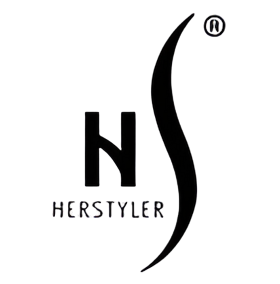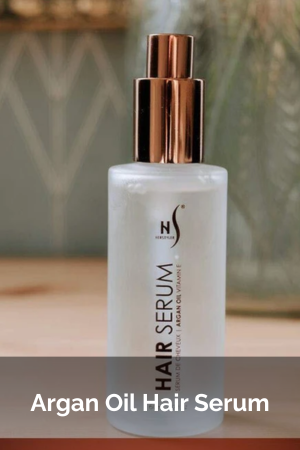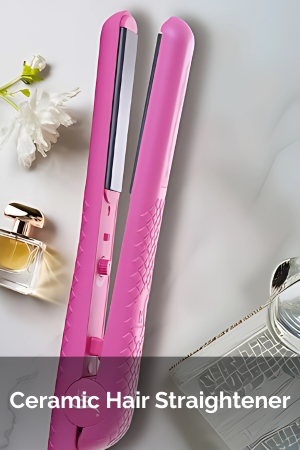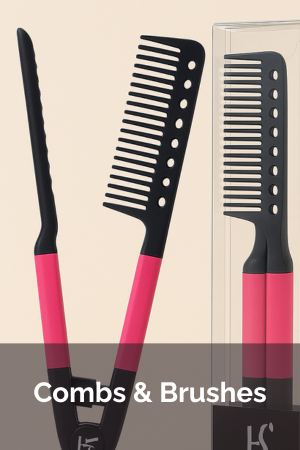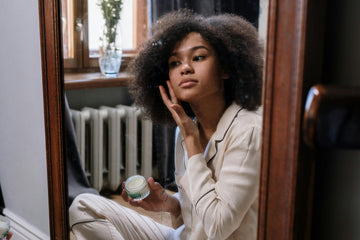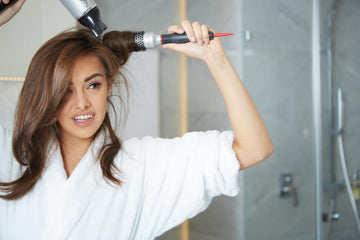The natural hair movement has been making waves lately, with more and more people choosing to embrace their beautifully textured curls. However, what comes next? How do you care for natural hair in a way that brings out its best, without having to deal with the unruliness and frizz that can often accompany it?
That’s where HerStyler can help! Read on as we share nine ways to give your natural hair the unique care that it needs.
1) Know How Often to Wash Your Natural Hair
One of the biggest mistakes that people with natural hair make is washing their hair too often. People with other hair types are often adamant about how vital it is to wash hair every couple of days but this doesn’t hold true for those with curly or coily hair.
Instead, the curlier your hair is, the less you should be washing it. Washing your hair removes the natural oils that keep your hair feeling protected and moisturized. This isn’t such an issue for those with straight hair because the scalp will soon produce more oil, which then easily slides down strands to nurture them from root to tip. However, that path isn’t as straightforward when it comes to curly hair. The oils produced by your scalp take a lot longer to make their way to the ends of your hair due to all of the bends and kinks that they have to travel over. You need to give them enough time to make this journey before washing your hair again.
So, how often should you be washing your natural hair? This greatly depends on your lifestyle, along with how dirty or sweaty your hair gets on a day-to-day basis. However, once a week would be a good place to start, and you can slowly extend this if your hair doesn’t seem to need to be washed quite so often.
2) Use a Conditioner With Plant Oils
 Moisture is something that coily, natural hair tends to lack. This is down to the reason that we discussed above – it takes so long for the scalp’s oils to travel down the hair shaft. This leaves the mid-lengths and ends of the hair particularly lacking.
Moisture is something that coily, natural hair tends to lack. This is down to the reason that we discussed above – it takes so long for the scalp’s oils to travel down the hair shaft. This leaves the mid-lengths and ends of the hair particularly lacking.
This is why it’s so important to condition natural hair after it has been washed. However, picking the right conditioner is vital. Natural hair requires a thicker and richer conditioner than other hair types.
One way to ensure that your conditioner is able to provide enough moisture is by choosing a formula that has been infused with plant oils. Not only will plant oils hydrate your strands, but they’ll help to seal in moisture while also pampering your mane with a plethora of antioxidants.
Argan oil is one that is revered for its antioxidant content. That’s why we’ve included argan oil in the HerStyler Argan Oil & Biotin Conditioner. The argan oil will moisturize your locks while the biotin will leave them feeling stronger. It’s perfect for natural hair!
3) Consider Co-washing
Some people with natural hair only need to wash their tresses every couple of weeks. However, what happens if your hair needs to be refreshed and moisturized in between washes?
That’s where co-washing comes in. This is when you wash your hair with a conditioner instead of a shampoo. It enables you to squeeze in an extra wash day without running the risk of drying out your strands or stripping away your natural oils. You apply the conditioner in the same way that you would a shampoo, taking extra care to ensure that every last trace of it is rinsed out once you’re done since you don’t want your roots to feel weighed down.
Since product buildup occurs more easily when co-washing, avoid co-washing your locks back to back. Instead, aim for just one co-washing session in between shampoo days, so that your shampoo is able to remove any build-up with ease.
4) Detangle Your Hair With Your Fingers Before Combing Through
 Due to all of the curls and kinks that natural hair has, it tends to be highly prone to tangles. Not only can de-tangling all of that hair feel like a chore, but do it in the wrong way and you could end up damaging your locks. Any sort of tension placed on the roots is bad news, and de-tangling often involves a fair amount of pulling and tugging!
Due to all of the curls and kinks that natural hair has, it tends to be highly prone to tangles. Not only can de-tangling all of that hair feel like a chore, but do it in the wrong way and you could end up damaging your locks. Any sort of tension placed on the roots is bad news, and de-tangling often involves a fair amount of pulling and tugging!
To avoid breakages and frizz, be gentle when de-tangling your mane. Start by using your fingers, running them through your strands and using them to work apart any tangles. You won’t get them all with your fingers but you should be able to separate quite a few of your knots.
Once you’re done with round one, reach for a wide-toothed comb and continue working on your tangles. This should help you to remove most of them. The final step is to turn to a de-tangling brush, like the HerStyler Pro Detangler Brush, to complete the job.
Whenever possible, save your de-tangling efforts for when you have some time to spare. If you’re in a rush, you’re more likely to be rough and forceful with your hair, which isn’t going to do the health of your mane any good!
5) Experiment With Protective Hairstyles
A protective hairstyle is one that keeps the hair tucked away, safe from environmental damage. Due to how fragile natural hair can be, protective hairstyles are often a go-to for those with curls and coils.
Unfortunately, not all of the reputed protective hairstyles out there actually protect your locks. From twists to braids, many of these styles have the potential to protect. However, when created too tightly, they can actually contribute to breakages, hair thinning, and hair loss.
The solution is to experiment with protective hairstyles that don’t pull at your roots. If your hairstyle hurts in any way or if you’ve noticed small bumps appearing at your hairline, then this is a sign that your hairstyle is too tight. Opt for a low-manipulation hairstyle instead, such as loose braids or a soft bun. This way, any tension placed on your strands will be minimal and your scalp will be able to breathe.
6) Turn Down the Temperature When Heat Styling
 Due to how dry and fragile it is, natural hair is extremely susceptible to heat damage. The best way to prevent this is to avoid heat styling as much as possible.
Due to how dry and fragile it is, natural hair is extremely susceptible to heat damage. The best way to prevent this is to avoid heat styling as much as possible.
However, when you do need to heat style your mane, be very careful about the temperature that you use. With natural hair often being quite thick and coarse, it can be tempting to crank your styling tools up to their hottest temperature. Sure, this may get the job done quickly but it will also cause some serious damage to your hair, especially if you regularly heat style.
Instead, try using a lower temperature. It shouldn’t be so low to the point where you have to repeatedly run your styling tools over the same section of hair multiple times, as this will also contribute to damage. However, chances are that you’ll be able to get away with using a lower-than-maximum temperature, so that you can style your hair to perfection without leaving it feeling scorched.
What happens if your heated styling tools don’t have an adjustable temperature dial? For the sake of your natural hair, it’s time to invest in products that do. The HerStyler Forever Black flat iron, for example, not only enables you to adjust the amount of heat that’s emitted, but between its 100% ceramic plates, far infrared technology, and negative ion technology, your hair will look beautifully soft and healthy once you’re done styling.
7) Get Rid of Split Ends With Regular Trims
Split ends occur for a number of reasons. Daily wear and tear, harsh de-tangling, excessive heat styling, the weather…the list goes on!
While there may be a number of products out there that promise to repair split ends, take these with a pinch of salt. In reality, it’s not actually possible to fix split ends. Once those ends are split, those hairs are broken and cannot be put back together. Instead, those splits will only slowly work their way up your hair shaft, causing more of your hair to look brittle and unhealthy.
To prevent this, you’ll need to regularly get rid of any split ends, and the only way to do this is by trimming them off. This can be heartbreaking if you’re trying to grow your hair but it’s a necessity. Opt for regular trims and you’ll only need to have a few millimeters removed each time. This won’t make a significant difference to your overall length. In fact, it will likely help hair growth since split ends can inhibit length retention.
8) Take Care of Your Scalp
Your hair grows from your scalp. So, it goes without saying that the healthier your scalp is, the healthier your hair will be. This is something that applies to all hair types and textures, including natural hair.
More and more people are realizing how important scalp care is. This is why there are now so many scalp care products out there that you can turn to. From scalp serums to scalp scrubs to scalp derma rollers, each one will give your scalp the TLC that it needs to produce strong and vibrant hairs.
Figure out what your scalp needs, whether it may be moisture, a boost in circulation, or anything else, and then find yourself some scalp care products that will help you give your scalp just that.
9) Cover Up in Harsh Weather
We’ve talked about how excessive heat can quickly damage natural hair, but harsh weather can also have the same effect. From strong winds to bitter cold to scorching heat, all of these environmental factors can cause natural hair to turn dry, dull, and brittle.
If you want your hair to look its best, environmental protection is a must. Whenever possible, cover your hair up during harsh weather conditions to keep it protected. Whether you tie it up into a loose style and tuck it under a hat or wrap your long lengths in a silk scarf, providing an additional barrier between your hair and the environment will do the world of good!
Summary
There’s no denying that natural hair can be tough to care for at first, particularly since it differs from other hair types and textures in so many ways. However, follow the tips above and you’ll be on the right track to giving your mane everything that it needs to look its very best.
Click here to pamper your natural hair with more bestsellers from HerStyler.

